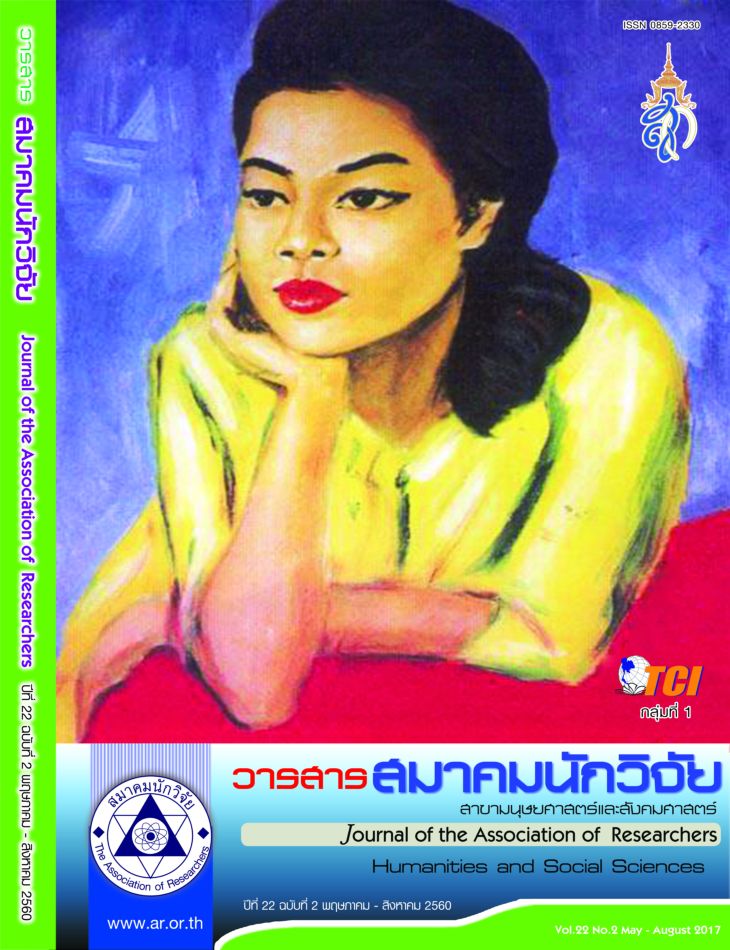Composition of Team Learning Behavioral of Srinakharinwirot University Student 1
Main Article Content
Abstract
The objective of this research is to study composition of team learning behaviors of Srinakharinwirot University’s students. The samples were divided into two groups. One group consisted of 361 third-year undergraduate students for exploratory factor analysis and the other group consisted of 391 third-year undergraduate students for the second order confirmatory factor analysis. For this study, the research instrument was questionnaires with 5 rating scale, totaling 29 questions. The results showed that (1) the exploratory factor analysis of team learning behaviors of Srinakharinwirot University’s students comprised of three components: (1.1) a team leadership consisted of nine indicators (1.2), a collaboration in the teams consisted of 12 indicators, and (1.3) an applying knowledge in the teams consisted of eight indicators; 2) The results of the confirmatory factor analysis from finding components demonstrated
that model of team learning behaviors of Srinakharinwirot University’s students was consistent with the empirical data (χ2= 424.28 df= 302, p-value = 0.00000, Relative χ2= 1.40, RMSEA =, RMR =, SRMR=, CFI= .99, GFI = . 93, AGFI = .90, CN = 340.84). The component of the collaboration in the teams was the
highest weight of each factor equal to .96 for 12 indicators and the weight of each factor was between.52 and .73. Following by applying knowledge in the teams where the weight of each factor equal to.93 for eight indicators and the weight of each factor were between .59 and .67. The team leadership
had the weight of each factor equal to .81 for nine indicators and the weight of each factor were between .51 and .72
Article Details
บทความที่ปรากฏในวารสารนี้ เป็นความรับผิดชอบของผู้เขียน ซึ่งสมาคมนักวิจัยไม่จำเป็นต้องเห็นด้วยเสมอไป การนำเสนอผลงานวิจัยและบทความในวารสารนี้ไปเผยแพร่สามารถกระทำได้ โดยระบุแหล่งอ้างอิงจาก "วารสารสมาคมนักวิจัย"
References
ณัฏฐ์สิตา ศิริรัตน์. (2551). รูปแบบการแลกเปลี่ยนเรียนรู้บนเครือข่ายตามแนวคิดการเรียนรู้ แบบชี้นำตนเองเพื่อสร้างการเรียนรู้ร่วมกันเป็นทีมสำหรับบุคลากรทางการศึกษา. วิทยานิพนธ์ปริญญา ครุศาสตรดุษฎีบัณฑิต สาขาวิชาเทคโนโลยีและสื่อสารการศึกษา บัณฑิตวิทยาลัยจุฬาลงกรณ์มหาวิทยาลัย.
รัฐพล ประดับเวทย์. (2551). การพัฒนารูปแบบการเรียนการสอนบนเครือข่ายอินเทอร์เน็ตเพื่อสร้างเสริมความสามารถในการทำงานเป็นทีม ของนิสิตในระดับอุดมศึกษา. ปริญญานิพนธ์ กศ.ด. (เทคโนโลยีการศึกษา). กรุงเทพฯ:บัณฑิตวิทยาลัย มหาวิทยาลัยศรีนครินทรวิโรฒ.
รุ่งรดิศ คงยั่งยืน (2560) องค์การแห่งการเรียนรู้ บรรยากาศองค์การ พฤติกรรมการเป็นสมาชิกที่ดีขององค์การและการแบ่งปันความรู้ของหน่วยงานในฝ่ายช่าง บริษัท การบินไทย จำกัด (มหาชน). วารสารสมาคมนักวิจัย. 22 (1) :150 – 162.
วาสนา รังสร้อย และ บัณฑิต ผังนิรันดร์ (2560). การพัฒนารูปแบบการจัดการเรียนรู้ด้านการคิดอย่างมีวิจารณญาณกลุ่มสาระการเรียนรู้สังคมศึกษา ศาสนาและวัฒนธรรมของนักเรียนระดับ ประถมศึกษา. วารสารสมาคมนักวิจัย. 22(1) : 98 – 113.
สุชาติ กิจธนะเสรี (2555). การก้าวสู่องค์กรแห่งการเรียนรู้. กรุงเทพฯ: สำนักงานพัฒนาวิทยาศาสตร์และเทคโนโลยีแห่งชาติ.
สุรมน ไทยเกษม (2558). การพัฒนาแบบวัดภาวะผู้นำแบบผู้รับใช้ของผู้ประกอบการในวิสาหกิจขนาดกลาง และขนาดย่อมในจังหวัดฉะเชิงเทรา. 20 (2): 59 - 69.
Referances
Ali, E. A, Gary, S. L, Halit, K & Derya, D (2014). Team Learning in IT Implementation Projects: Antecedents and Consequences. International Journal of Information Management. 34 (2014): 37– 47.
Aranda, E.K., Aranda, L. & Conlon, K. (2003). Teams: Structure, Process, Culture and Politics. Singapore:Prentice Hall.
Argyris, C. (1999). On Organizational Learning. Massachusetts: Blackwell Publishers Inc.
Beiqun, Z &, Donald, D. P (2016). Comparison of Lecture-Based Learning vs Discussion-Based Learning in Undergraduate Medical. Journal of Surgical Education.73 (2) : 250-257.
Decuyper, S., Dochy, F., & Van den Bossche, P. (2010). Grasping the Dynamic Complexity ofTeam Learning:An Integrative Model for Effective Team Learning in Organizations. Educational Research Review.5(2): 111–133.
Donnellon, A. (2006). Leading Teams. Boston: Harvard Business School Press.
Gavin. D.A. (2000). Building Learning Organization. Boston: Havard Business Review.
Hae-Ran, K., Yeoungsuk, S, Ruth, L & Hee-Young, K (2015) Effects of Team-Based Learning on Problem-Solving, Knowledge and Clinical Performance of Korean Nursing Students. Nurse EducationToday In press. 2015: 1 - 14
Huang, Jing - Wen Li, Yong – Hui (2012). Slack Resources in Team Learning and Project Performance. Journal of Business Research. 65(3): 381-388.
Johnson, D.W., & Johnson, F.F. (2000). Joining Together: Group Theory and Group Skill (7 rd ed.). Boston:Allyn and Bacon.
Marquardt, M (1996). Building the Learning Organization. New York: McGraw-Hill
Michaelsen, L. K. (2008). Team-Based Learning for Health Professions Education: A Guide to Using Small
Groups For Improving Learning. 1sted., Sterling,VA: Stylus; 2008.
Michaelsen, L K, Knight A B, & Fink, L. D. (2002). Team-Based Learning: A Transformative Use of Small Groups. Westport, CT: Praeger;
Papa, M. J., Daniels, T. D., & Spiker, B. K. (2008). Organizational Communication: Perspectives and Trends. Thousand Oaks: Sage Publications.
Polzer, R. J. (2004). Creating Team With an Edge. Boston : Harvard Business School Press.
Selma, V. d. H., Segers, M, & Karen A. J (2013). Towards a Contextualized Model of Team Learning Processes and Outcomes. Educational Research Review. 10 (2013): 1–12.
Senge, M. P. (1990). The Fifth Discipline: The Art & Practice of The Learning Organization.NewYork: Doubleday.
Spoelstra, H, Rosmalen, V. P, Houtmans, T &, Sloep, P (2015). Team Formation Instruments to Enhance Learner Interactions in Open Learning Environments. Computers in HumanBehavior. 45 (2015):11-20.
Taylor, R (2014). How Team Learning Benefits Families. Nursing Times.110(1-3) : 37.


